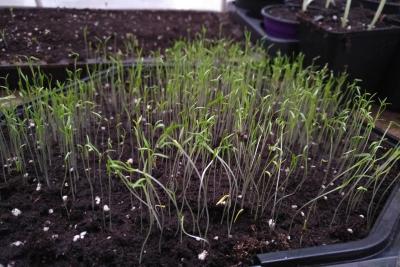
Our "Beta vulgaris" strated at first and began in the last days more slowly to grow but the most of it.
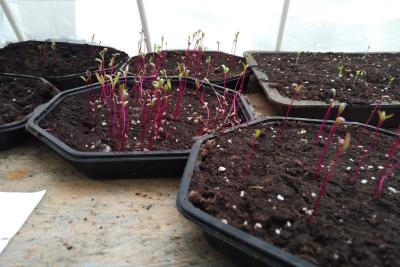
Our Oilpumkin are the winner! In a few day they got 10 centimeters in length! Wow.
Now we wait, that we get Weather with constant over 10 degrees, so that our Pumkins will not died.
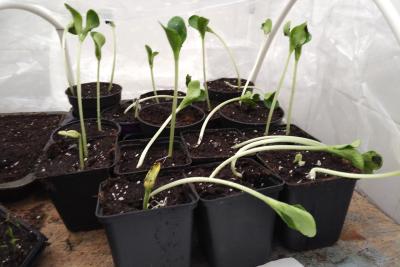
This actually pictures show the development of our seeds.
Thge next step will be dig the gardenbed for plant it. But on owing that our students have examniations we have to look if we get time.
... link (0 Kommentare) ... comment
The disk diffusion agar method tests the effectiveness of antibiotics on a specific microorganism. An agar plate is first spread with bacteria, then paper disks of antibiotics are added. The bacteria is allowed to grow on the agar media, and then observed. The amount of space around every antibiotic plate indicates the lethality of that antibiotic on the bacteria in question.
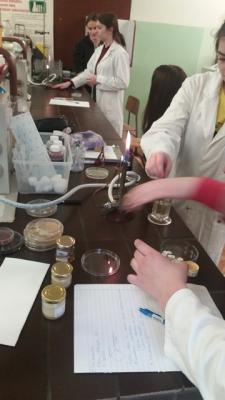
And how we made disk diffusion agar method test?
1. Using an aseptic technique, place a sterile swab into the broth culture of a specific organism and then gently remove the excess liquid by gently pressing or rotating the swab against the inside of the tube.
2. Using the swab, streak the Mueller-Hinton agar plate to form a bacterial lawn.
• To obtain uniform growth, streak the plate with the swab in one direction, rotate the plate 90° and streak the plate again in that direction.
• Repeat this rotation 3 times.
3. Allow the plate to dry for approximately 5 minutes.
4. Use disc without antibiotic and soak them in one of the bee products.
5. Using a flame-sterilized forceps, gently press each disc to the agar to ensure that the disc is attached to the agar.
6. Plates should be incubated 24 h at an incubation temperature of 37 °C (98.6 °F).
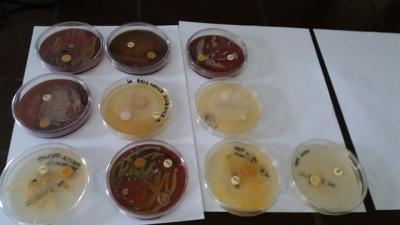
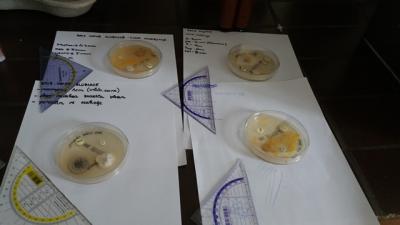

A: The swab of a the throat - human
B: The swab of the oral cavity of the cats
C: The swab of tonsils - human
D: The swab of the throat - human
E: The swab of the throat - human
F: Mastitis cysts in cattle
G: The pustules - human
H: The swab of the the gums - cat
I: The swab of the throat - human
J: The swab of the gums - dog
K: Abscesss - sheep
L: The swab of inflamed joint - goose
M: The swab of inflammated eye conjuctica - cat

... link (0 Kommentare) ... comment
This march 2018 was with coldest nights since a lot of years and colder than 1997. In 1997 there was one night by minus 4 degree. In 2018 we had one night by -4, two nights nearby -6 and one night much colder. And also three nights under zero to -1 degree.
1997 we had only four nights nearby -2 degrees. In the other years the temperature nearby zero and higher.
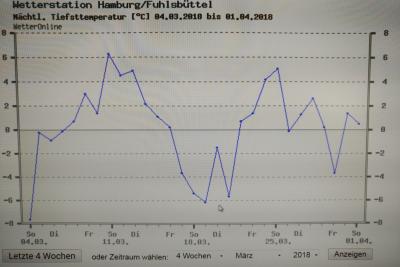
https://www.wetteronline.de/wetterdaten/hamburg?pcid=pc_rueckblick_data&gid=10147&pid=p_rueckblick_diagram&sid=StationHistory&iid=10147&metparaid=TNLD&period=4&month=03&year=2018
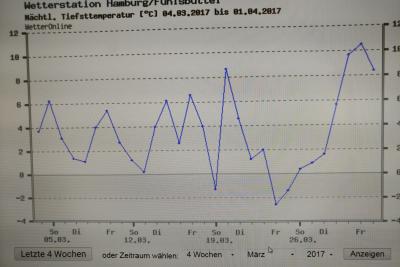
https://www.wetteronline.de/wetterdaten/hamburg?pcid=pc_rueckblick_data&gid=10147&pid=p_rueckblick_diagram&sid=StationHistory&iid=10147&metparaid=TNLD&period=4&month=03&year=2017
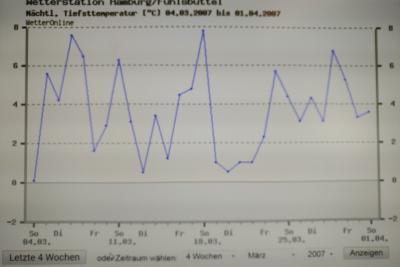
https://www.wetteronline.de/wetterdaten/hamburg?pcid=pc_rueckblick_data&gid=10147&pid=p_rueckblick_diagram&sid=StationHistory&iid=10147&metparaid=TNLD&period=4&month=03&year=2007

https://www.wetteronline.de/wetterdaten/hamburg?pcid=pc_rueckblick_data&gid=10147&pid=p_rueckblick_diagram&sid=StationHistory&iid=10147&metparaid=TNLD&period=4&month=03&year=1997
In this mounth isn`t a so clearly tendenz about Earthwarming discernible.
... link (0 Kommentare) ... comment
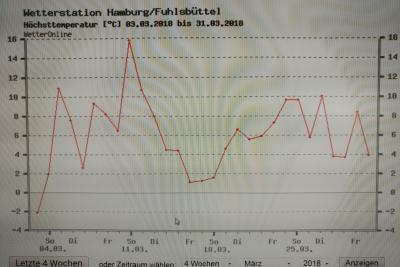
https://www.wetteronline.de/wetterdaten/hamburg?pcid=pc_rueckblick_data&gid=10147&pid=p_rueckblick_diagram&sid=StationHistory&iid=10147&metparaid=TXLD&period=4&month=03&year=2018

https://www.wetteronline.de/wetterdaten/hamburg?pcid=pc_rueckblick_data&gid=10147&pid=p_rueckblick_diagram&sid=StationHistory&iid=10147&metparaid=TXLD&period=4&month=03&year=2017

https://www.wetteronline.de/wetterdaten/hamburg?pcid=pc_rueckblick_data&gid=10147&pid=p_rueckblick_diagram&sid=StationHistory&iid=10147&metparaid=TXLD&period=4&month=03&year=2007

https://www.wetteronline.de/wetterdaten/hamburg?pcid=pc_rueckblick_data&gid=10147&pid=p_rueckblick_diagram&sid=StationHistory&iid=10147&metparaid=TXLD&period=4&month=03&year=1997
In the same way we can see that the year 2017 was special. We have high rise temperature beside a certain amount of hail in comparsion with the other years.
... link (0 Kommentare) ... comment

14 days with rain and snow-rain.
https://www.wetteronline.de/wetterdaten/hamburg?pcid=pc_rueckblick_data&gid=10147&pid=p_rueckblick_diagram&sid=StationHistory&iid=10147&metparaid=RR24&period=4&month=03&year=2018

13 days of rain.
https://www.wetteronline.de/wetterdaten/hamburg?pcid=pc_rueckblick_data&gid=10147&pid=p_rueckblick_diagram&sid=StationHistory&iid=10147&metparaid=RR24&period=4&month=03&year=2017
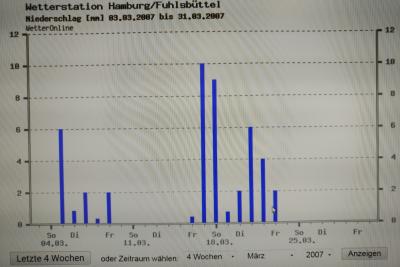
13 days of rain.
https://www.wetteronline.de/wetterdaten/hamburg?pcid=pc_rueckblick_data&gid=10147&pid=p_rueckblick_diagram&sid=StationHistory&iid=10147&metparaid=RR24&period=4&month=03&year=2007
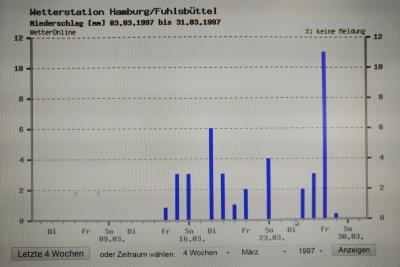
12 days of hail.
https://www.wetteronline.de/wetterdaten/hamburg?pcid=pc_rueckblick_data&gid=10147&pid=p_rueckblick_diagram&sid=StationHistory&iid=10147&metparaid=RR24&period=4&month=03&year=1997
By the diagrams you can`t see any extremly differents but you can see just as our older diagrams about the last year (2017), it was extremly wet.
... link (0 Kommentare) ... comment
In this actually week we have the examination of the junior high school by end of class 9. For the students with secondary modern school or higher, we offered a course to dissect a heart of a cow.
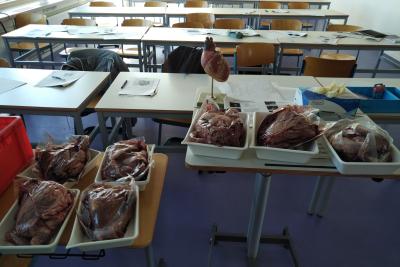
Our students had see the differnt parts of the heart and it`s structures and weighed it.

right ventricle and heart valve
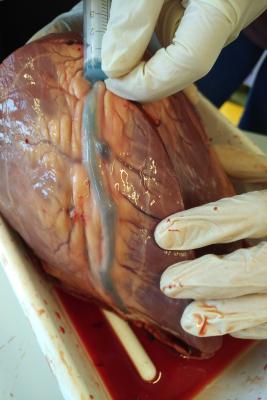
They fill the coronary vessel with coloured Water to see the connections.

The students are very interested in and work intensiv.
Very interseting was one heart which to gain weight and build illness structures at the epikard.

The students had in this way a comparison between a healthy and an ill heart. The fat-structures are very hart and in this way the heart can`t work correctly.
... link (0 Kommentare) ... comment
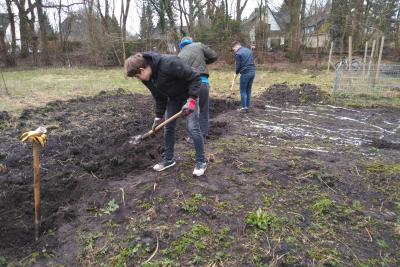
We dig it over and put on a new fence to protect them.
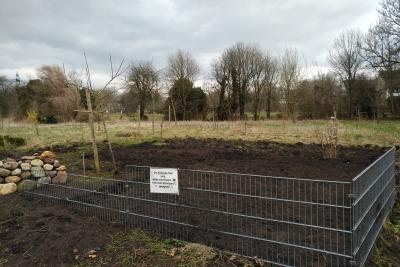
On the left side you can see a part of our growing naturalstone wall, where we will plant: Rosmarinus officinalis, Thymus, Lavandula angustifolia
The leafs and blossoms we want to use ffor tea, soap and pomander.
In a old male toilette we construct a greenhouse for our vegetable and pumkin seeds.
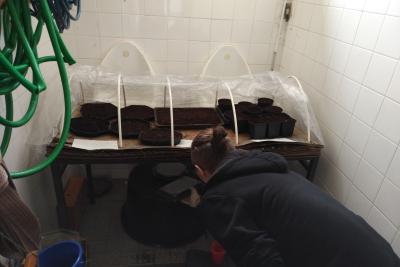
After one week we had see how fast it`s grow.

Pumkin seeds at 12.4.2018

Pumkin seeds 19.4.2018
You can see how it grow.
Also the vegetables:
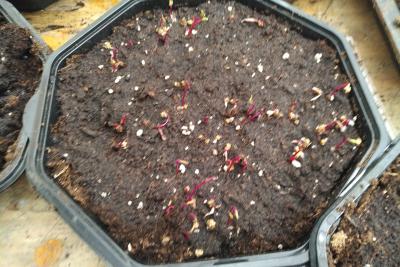
Beta vulgaris at the 12.4.2018

And at the 19.4.2018
... link (0 Kommentare) ... comment

Our "Rubus sectio Rubus" stared slowly two weeks ago, but grow really becuase the temperatures.

LAst week it was possible to see that the first energie gone into the bud from our wine from slovenia.
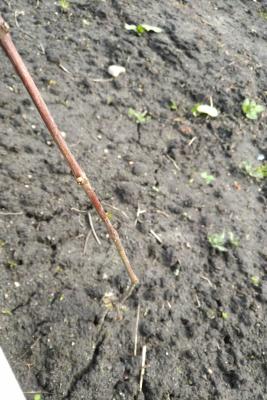
On thurday the 17.4.2017 we plant our new wine from the historic grapevine from Maribor which was brought from our collegues of the agriculture school there.
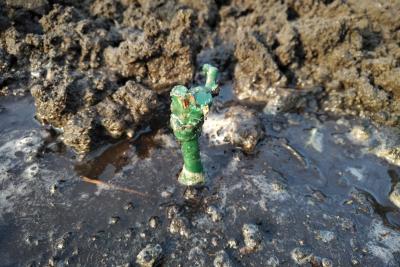
The students from Maribor showed us in November 2017 how to plant and how to cut the vine.
Now we hope that we don`t get some nights with frost.
Our apple-trees stared also with there first small buds.

Apple tree t 12.4.2018
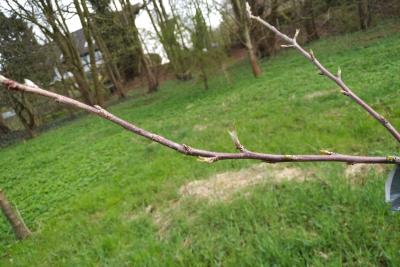
In one week it`s growing only a little more.
... link (0 Kommentare) ... comment
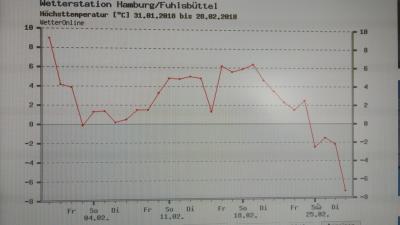
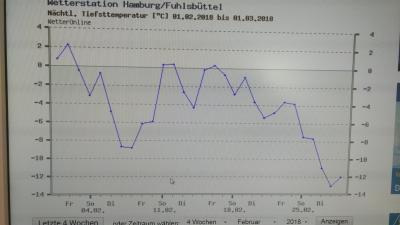
https://www.wetteronline.de/wetterdaten/hamburg?pcid=pc_rueckblick_data&gid=10147&pid=p_rueckblick_diagram&sid=StationHistory&iid=10147&metparaid=TNLD&period=4&month=02&year=2018

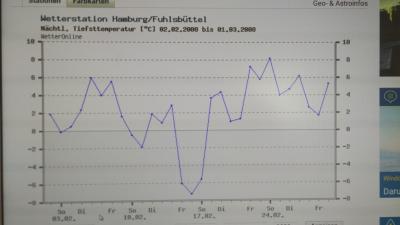
https://www.wetteronline.de/wetterdaten/hamburg?pcid=pc_rueckblick_data&gid=10147&pid=p_rueckblick_diagram&sid=StationHistory&iid=10147&metparaid=TNLD&period=4&month=02&year=2008
10 years ago the lowest temperature was -7 Degrees. The lowest temperature this year was -13 degrees.
In the year 1998 was one day with -11 degrees and in the year 1988 around -4 degrees.
If we go more years back, we would find one night with -17 degree in the 1978.
This February 2018 was the coldest winter month since the past 40 years. In this month the temperatures vary from between -10 to 0, up to between - 6 and +2 degrees.
In the last 20 year we had the most days with the temperature around 0 degree. T
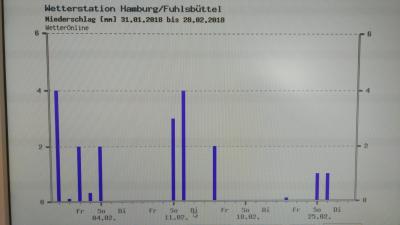
https://www.wetteronline.de/wetterdaten/hamburg?pcid=pc_rueckblick_data&gid=10147&pid=p_rueckblick_diagram&sid=StationHistory&iid=10147&metparaid=TNLD&period=4&month=02&year=2018

https://www.wetteronline.de/wetterdaten/hamburg?pcid=pc_rueckblick_data&gid=10147&pid=p_rueckblick_diagram&sid=StationHistory&iid=10147&metparaid=TNLD&period=4&month=02&year=2008
In the last year we had almost the same rainy days, comparing to the years before, but we can see that the trend is going down. In the February 2008 we had one day with over 14 mm of rain - in the February 2018 we had only one day with 4 mm per square meter.
In the year 1998 we had a day with 8 mm and in the February 1978 we had max 4 mm/square meter.
In the year 1978 were 16 rainy days and in the year 1988 there were 24 days. The amount of days follow the lower level of hail. Nevertheless this February was the coldest February since 1978.
We can see that the trend of temperature is raising over the months and the amount of water/square meter is going down.
To sum up, we can see, that this month was the driest since 2017.
... link (0 Kommentare) ... comment
The average monthly temperature was also significantly lower than the average of the period from 1981 to 2010, it was - 1,41 °C, and it was 3,11 °C lower than the long-term average. The long-term average for February is 1.7 °C in Maribor. However, if we compare only the average temperature of the last week with the average of the period from 1981 to 2010, it was found that it was lower by as much as 8.28 °C.
In February, the average temperature was nine times above the freezing point (0 °C). From 22nd to 28th February the maximum temperature did not exceed 0 °C. The minimum daily temperature was below the freezing point. The lowest temperature in February was - 20.2 °C, and the highest temperature was 11.58 °C.
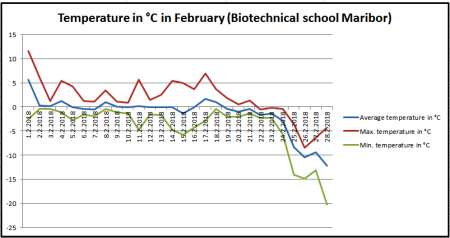
Precipitation data show that February was rich in precipitation. The first part of the month was rainy, while in the second part there was a lot of snow, which the measuring device did not detect. We can say that the precipitation was much higher than the graph shows. Precipitation during February was above average. The measuring device detected 78.6 mm of precipitation, which is about twice as long as the long-term average (38 mm of precipitation). The meteorological station in the center of Maribor detected 121 mm of precipitation. Most precipitation fell in the first half of the month.

According to the data of the meteorological station in the center of Maribor, there was 106.8 cm of snowfall in February.
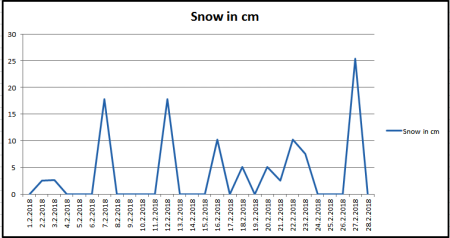
The average relative humidity in February was 86.42 %, which is approximately the same as in January.
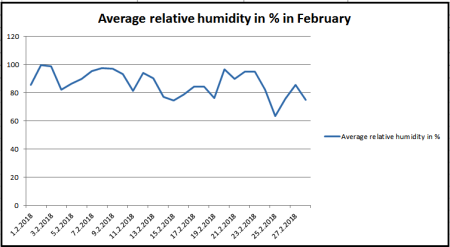
... link (0 Kommentare) ... comment
We´re planing to build our own weather station, but the software is tricky and gave us a lot complications, that is why, we can only use the data from the weather station in Fuhlsbüttel.
Next graphic show us the data of temperature from January.
The first highest peak follows from the lowest peaks oft the temperature.
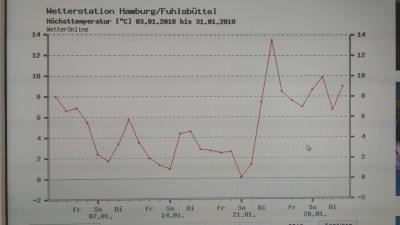
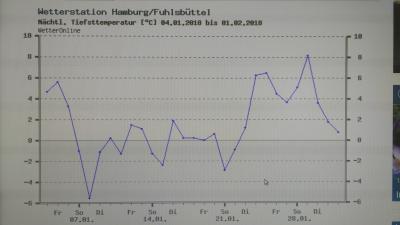
https://www.wetteronline.de/wetterdaten/hamburg?pcid=pc_rueckblick_data&gid=10147&pid=p_rueckblick_diagram&sid=StationHistory&iid=10147&month=01&year=2018&period=4&metparaid=RR24
The last graphic shows the peaks of rain in millimetre per square meter.
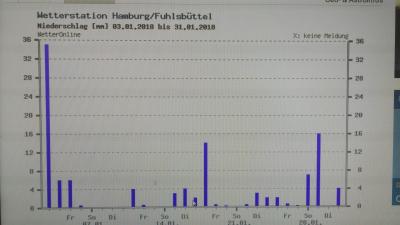
https://www.wetteronline.de/wetterdaten/hamburg?pcid=pc_rueckblick_data&gid=10147&pid=p_rueckblick_diagram&sid=StationHistory&iid=10147&month=01&year=2018&period=4&metparaid=RR24
If we look at the temperatures, we can see that with the low temperatures also came less rain.
The highest peaks of temperature, compare to January 2018, are 14 degree, in January 2008 are 12 degrees and in 1998 are 13 degrees. The temperature are from year to year raising. The highest temperature in 1998 is on most of the days around 0 degree or bellow it. In the following years the temperatures are going higher.
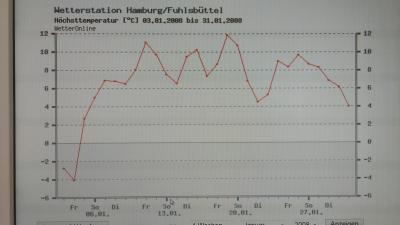
https://www.wetteronline.de/wetterdaten/hamburg?pcid=pc_rueckblick_data&gid=10147&pid=p_rueckblick_diagram&sid=StationHistory&iid=10147&metparaid=RR24&period=4&month=01&year=2008
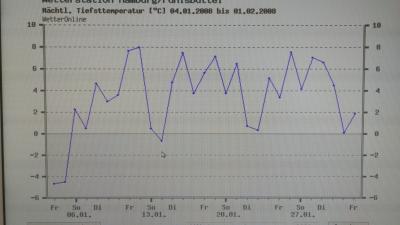
https://www.wetteronline.de/wetterdaten/hamburg?pcid=pc_rueckblick_data&gid=10147&pid=p_rueckblick_diagram&sid=StationHistory&iid=10147&metparaid=RR24&period=4&month=01&year=2008
If you look at the night temperature you will see that in January 2018 they lying between + 8 an -6 degree, in January 2008 between +8 and -4 degree an in January +6,5 and -11,5 degree. In the last 20 years the diverenz between the day and night temperature the high degrees take away from the lower degrees. The monthly shape of temperature graded up to 1,5 degree an the lowest by 5,5 degree.
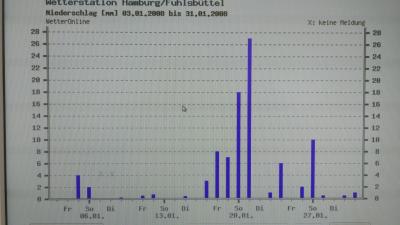
https://www.wetteronline.de/wetterdaten/hamburg?pcid=pc_rueckblick_data&gid=10147&pid=p_rueckblick_diagram&sid=StationHistory&iid=10147&metparaid=RR24&period=4&month=01&year=2008

https://www.wetteronline.de/wetterdaten/hamburg?pcid=pc_rueckblick_data&gid=10147&pid=p_rueckblick_diagram&sid=StationHistory&iid=10147&metparaid=RR24&period=4&month=01&year=1998

https://www.wetteronline.de/wetterdaten/hamburg?pcid=pc_rueckblick_data&gid=10147&pid=p_rueckblick_diagram&sid=StationHistory&iid=10147&metparaid=RR24&period=4&month=01&year=1998

https://www.wetteronline.de/wetterdaten/hamburg?pcid=pc_rueckblick_data&gid=10147&pid=p_rueckblick_diagram&sid=StationHistory&iid=10147&metparaid=RR24&period=4&month=01&year=1998
The precipitation show us only small differents. all years have compact a couple of day with precipitations. Ther e is a different between on which days. In the last ten year we get two more days with rain in January. The day with a high level of rain ar between 19 mm per squaremeter and 27mm. Possibly intersting is taht later days in month the precipitation get higher.
Shurely is that it`s was rain because the temperature are higher. Also are the temperature lower there are less decipitations.
... link (0 Kommentare) ... comment
The average monthly temperature was also significantly higher than the average of the period from 1981 to 2010, it was 2.87 °C and it was 2.97 °C higher than the long-term average. The long-term average for January is - 0.1 °C in Maribor.
In January, the average temperature was only four times below the freezing point (0 °C). Only one day the maximum temperature did not exceed 0 °C. The lowest temperature in January was only - 5.32 °C, and the highest temperature was 16.51 °C.

Precipitation data is reversed. Precipitation during January was above average. There were nine rainy days, with 44.4 mm of precipitation, which is 27 % more than the long-term average (35 mm of precipitation). Most precipitation fell on the first day of the year and in the period from 9 to 16 January.
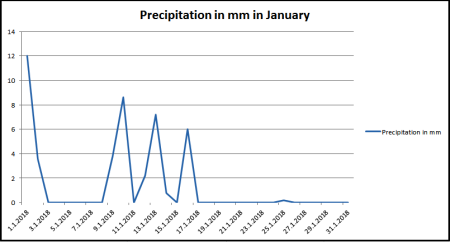
The average relative humidity in January was 85.28 %.

... link (0 Kommentare) ... comment
The weather station is type A733 and has a basic set of sensors - sensor for measuring air temperature, relative humidity, precipitation sensor and wetness sensor. From the obtained data we can calculate the average temperature, the highest and the lowest daily temperature, the daily amount of precipitation and the average relative humidity. The data obtained will be compared with the data from the period from 1981 to 2010.
In addition to meteorological data, we will also monitor phenological phases of the plants (fruit trees, pumpkins, potatoes, etc.) and we will also photograph them.
The weather data and phenological phases will also be monitored in Hamburg. Thus, we can compare the development of weather and plants in two completely different locations.
The data will also be presented in graphic form.
We will publish the reports on the blog.
... link (0 Kommentare) ... comment
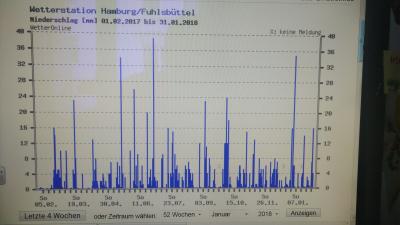
https://www.wetteronline.de/wetterdaten/hamburg?pcid=pc_rueckblick_data&gid=10147&pid=p_rueckblick_diagram&sid=StationHistory&iid=10147&month=01&year=2018&period=52&metparaid=RR24
The rainfall in this year was very unusual - the temperatures were higher for the December, also comparing with the last year. It`s warmer.
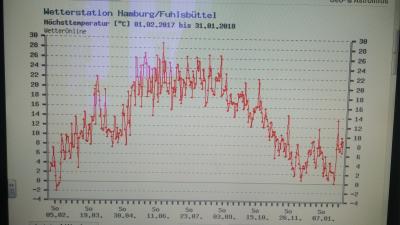
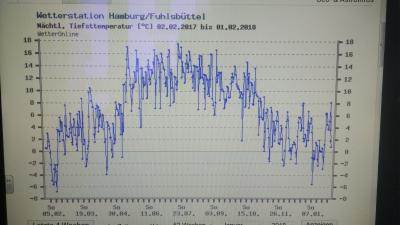
https://www.wetteronline.de/wetterdaten/hamburg?pcid=pc_rueckblick_data&gid=10147&pid=p_rueckblick_diagram&sid=StationHistory&iid=10147&month=01&year=2018&period=52&metparaid=TXLD
The following graphics will show your the temperatures of the last twenty years for the window from 7th of November to the 1st of January. It`s shows the winter from 2017/18, `15/`16, `14/`15,`07/`08 and `97/`98. Two things you will see over the years: The temperature gets more different peaks between high and low temperature per day. The other one is, that the peaks in 1997/98 only have 11 days over 10 degrees and often bellow 0 degree. In 2008 the most of the peaks have over 0 degree and only 16 day bellow. The difference between the highest and the lowest peaks per day are often far apart.
The last days in year 2018 we had a lot of rainy days, that lower the degrees, but we had rarely temperatures bellow 0 degree.
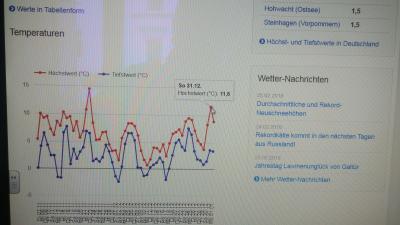
https://www.wetterkontor.de/de/wetter/deutschland/rueckblick.asp?id=80&datum=01.01.2018&t=8
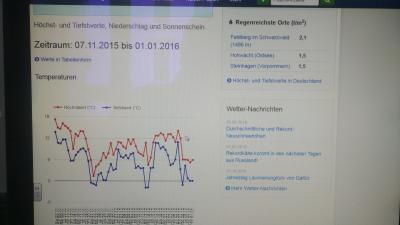
https://www.wetterkontor.de/de/wetter/deutschland/rueckblick.asp?id=80&datum=01.01.2016&t=8
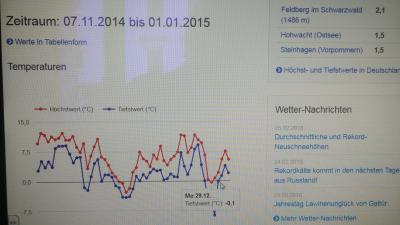
https://www.wetterkontor.de/de/wetter/deutschland/rueckblick.asp?id=80&datum=01.01.2015&t=8

https://www.wetterkontor.de/de/wetter/deutschland/rueckblick.asp?id=80&datum=01.01.2008&t=8
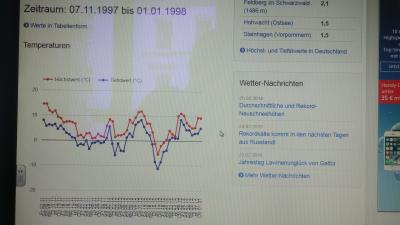
https://www.wetterkontor.de/de/wetter/deutschland/rueckblick.asp?id=80&datum=01.01.1998&t=8
The same phenomenon we can see by the rainy days in Hamburg. In the last twenty years we had regular compresses times and days with high level of the rain. In 1998 we had days with maximum rain with cca 10 Liter per square meter with peaks in three phases in the year. And one day with 14L of rain. In 2008 we have less days of rain (29) in compare to 1998 (31) in the same window of time. But in 2008 there is a highest peak with over 35 Liter per square meter.
In all the twenty years the rain was usually not higher than 10 L per square meter. In year 1998 the rain was around by 6 L and only one day by 12 Liter.
In the last winter we had 42 days of rain in our window of time and five days over or by 10 l per square meter.
Like we can see on the graphic, we had more rain than al the last twenty years or the days with the highest temperatures!
We can see, that the climate is changing.
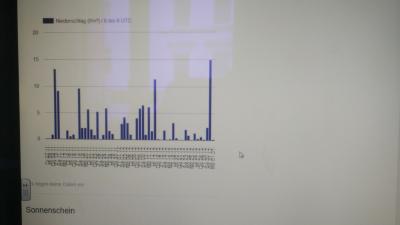
https://www.wetterkontor.de/de/wetter/deutschland/rueckblick.asp?id=80&datum=01.01.2018&t=8

https://www.wetterkontor.de/de/wetter/deutschland/rueckblick.asp?id=80&datum=01.01.2016&t=8

https://www.wetterkontor.de/de/wetter/deutschland/rueckblick.asp?id=80&datum=01.01.2015&t=8
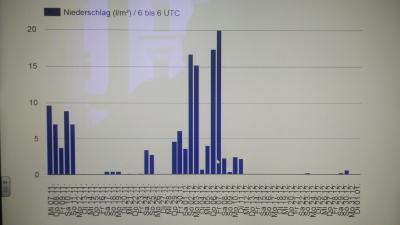
https://www.wetterkontor.de/de/wetter/deutschland/rueckblick.asp?id=80&datum=01.01.2008&t=8

https://www.wetterkontor.de/de/wetter/deutschland/rueckblick.asp?id=80&datum=01.01.1998&t=8
All the graphics show us, that the average temperature raise up over the years. And the rainy days follows the highest level amount of water.
This climate makes it possible, that pumpkins and vine from Slovenia would also grow in Hamburg.
... link (0 Kommentare) ... comment

Why is cold pressed pumpkin oil so good for our skin?
Packed with essential fatty acids, vitamins, minerals, antioxidants, and more, the oil from pumpkin seeds helps soothe, hydrate, protect, and renew your look—making it a great ingredient for anti-aging formulas. The natural nutrients in pumpkin seeks, particularly zinc and vitamin C, help firm and tighten. That same zinc along with natural selenium helps with oily skin, helping it to look healthy and clean. A rich source of vitamin E, which is a potent antioxidant, pumpkin seed oil protects skin from environmental stressors. The essential fatty acids sink deeply into skin to provide long-lasting moisturization without greasiness. These acids also help balance oil, moisturizing dry skin and controlling oily skin. Natural properties of pumpkin seed work great with sensitive skin.
Which cosmetics products we made from cold pressed pumpkin oil?
Pumpkin soap
We melted coconut oil and added pumpkin and sunflower oil.
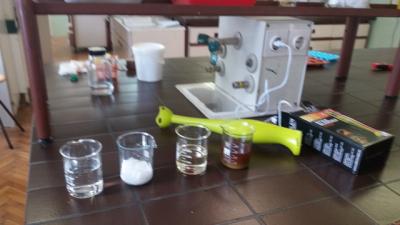
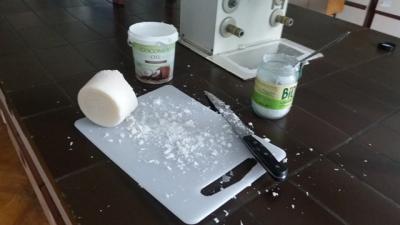
We warmed up this mixture for a while. In the meantime we added sodium hydroxide to the hydrolate. When this mixture has the same temperature as the oils, we mixed them together. We added also some ground pumpkin seeds.
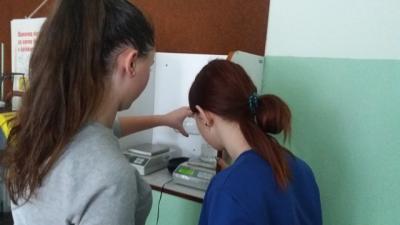
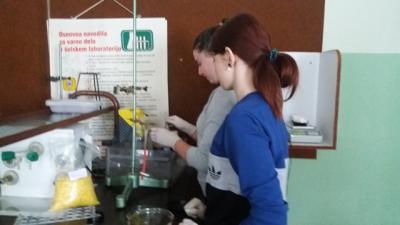
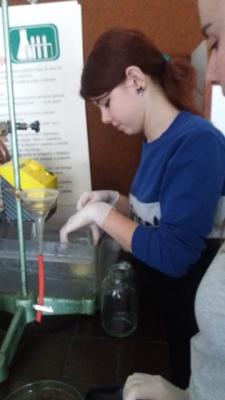
When the mass was like a puding we filled it in a soap models.

We wait three days, than we took soaps out of models. We must leave soaps 6 week to mature.
Pumpkin lip balm
To pumpkin oil we can add olive oil or cocconut oil. We melted all thise oils and added some wax. We poured it in lip balm tubes and waited that they solidify.

Nursing tablets
For them we melted wax an than added him caccao butter and pumpkin oil. We can add this mass also some esential oils and ground pumpkin seeds. We filled the mass in the models and wait that it solidify.
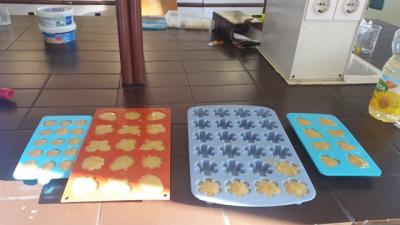
We can use this tablets after showering.
What are other advantages and effects of pumpkin oil?
Cold pressed pumpkin oil has a very beneficial effect on the function of the male prostate.
The oil is rich in a high content of delta-7-sterols that works against prostate enlargement (1g of oil contains 5 mg). Unsaturated fatty acids in conjunction with other substances have a positive effect on the metabolism of helostorel.
... link (0 Kommentare) ... comment
Propolis contains antioxidant flavonoids, such as quercetin, pinocembrin, galangin and pinobanksin. Other compounds which are found in Propolis include; caffeic acid and hydroquinone, which are among the best known compounds used in most commercial cosmetic formulas to treat acne and other skin related infections. Propolis also contain minerals, such as magnesium, calcium, nickel and zinc, which are beneficial in rebuilding damaged skin cells, as well as giving you nourished, soft skin. Propolis can be used in the treatment and cure of acne. Propolis is also ideal in removing inflammations which cause bacteria responsible for the formation of nodules on your skin.
For honey soap we were melting glyceine base in a water bath. When it was melted we added wax and when it was melted we added honey. We mixed everythin well and added five droplets of essential oil of lavender. The resulting mass was poured into the soap models. We waited one day, than we putted soaps from models.
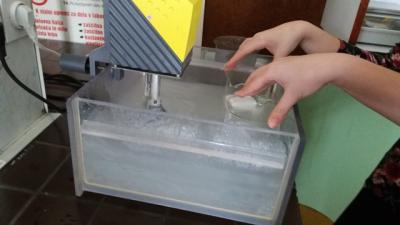
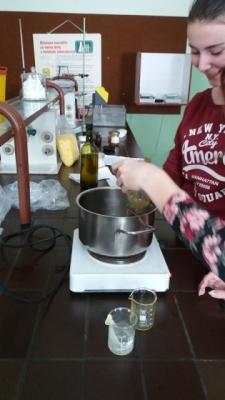
For propolis soap we were melting glycerine base in a water bath. In a water bath we were also heating the propolis tincture, so that the most of alcohol evaporated from it. We heated the honey to 45°C. We added propolis and honey to the malted glycerin, mixed it well and poured it into soap models. We waiting one day, than we putted soaps from models.
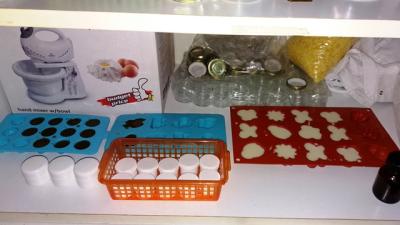
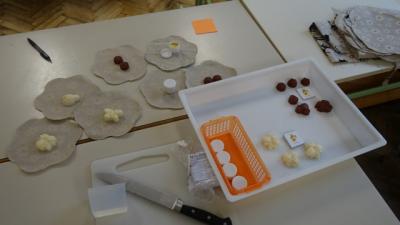
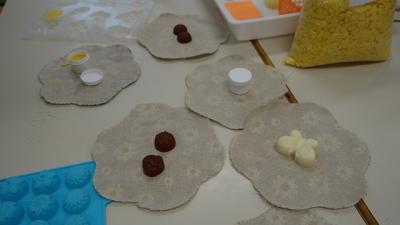
For propolis ointment we were heating separately honey, olive oil, wax, propolis tincture. Than we mixed everything together and poured it into storage jars while it was still warm. To avoid condensation allow the ointment to cool completely before securing with a lid.
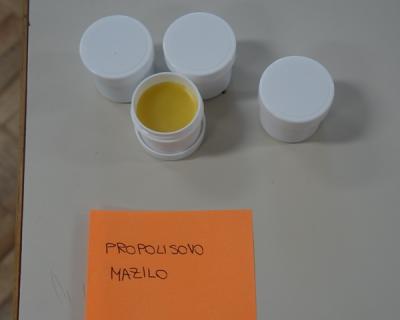
... link (0 Kommentare) ... comment
Contrary to popular belief, creamed honey is not whipped such us whipped cream. It is actually crystalized. The difference between creamed honey and the nasty, gritty honey is the size of the crystals. Creamed honey has tiny, silky, smooth crystals.
How we made it?
First we need a mixer for dough with a pot. We filled it with honey. We added two spoons of crystallized honey and mixed this mixture. We mixed it for 15 minutes, than we cooled it and wait one hour, than we mixed it again for 15 minutes. We repeated that three days during the day. After three days we added the mixture polen, royal jelly and propolis.
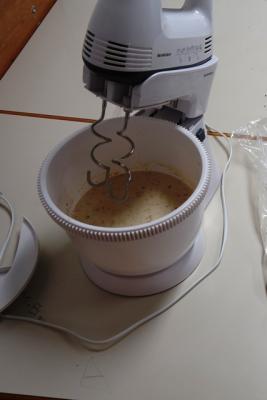
We mixed it 15 minutes and filled it in glasses.
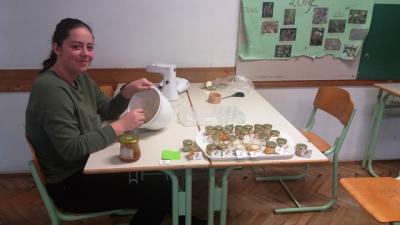

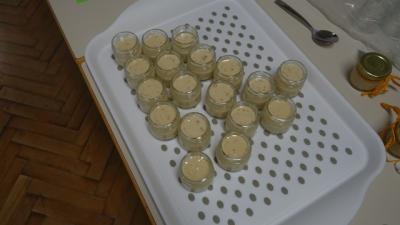
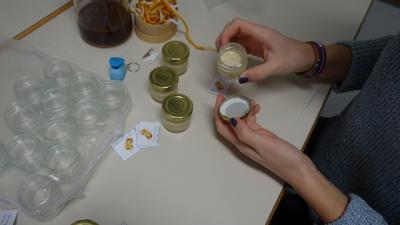
We putted the glasses in a fridge.
... link (0 Kommentare) ... comment
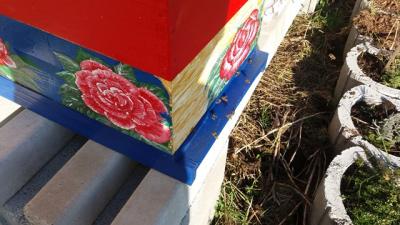
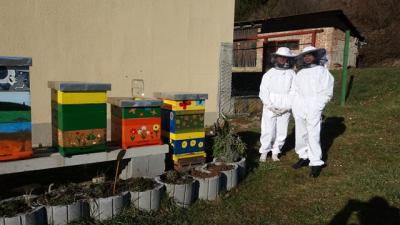
Because the temperature was appropriate, we began working in the bee garden. Our tractor driver Marko brought wooden beams for the pergola, which will support climbing plants.
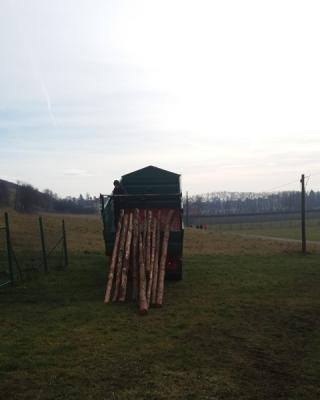
We planted Prunus avium, Erica carnea, Viburnum plicatum `Shasta`, Hedera helix, Vine (Isabella).
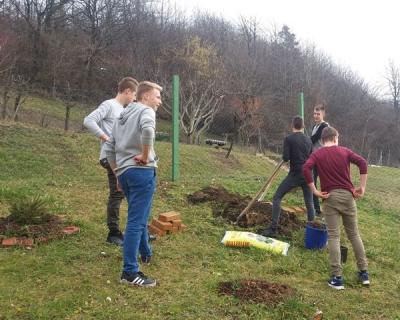
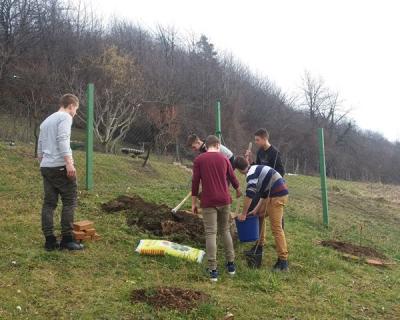
Girls sowed flower seeds into pots.
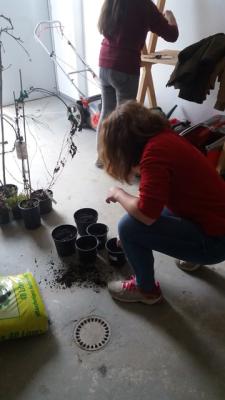
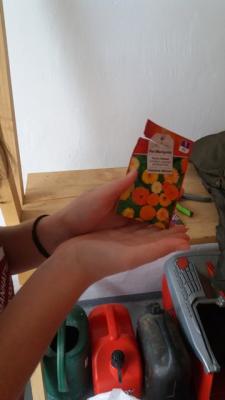
They also transplanted Parthenocissus quinquefolia and Clematis montana into larger pots. When the wooden pergola is finished, we will plant them outside.
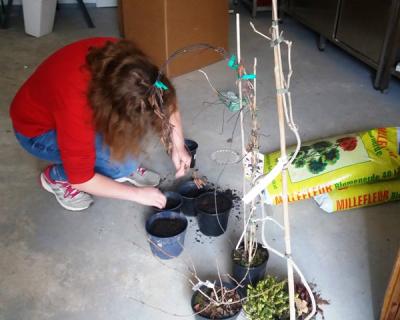

Some students dug the soil and prepared it for planting. They filled the wooden pallet with compost.
We got new hives and we will prepare them for new bee colonies.
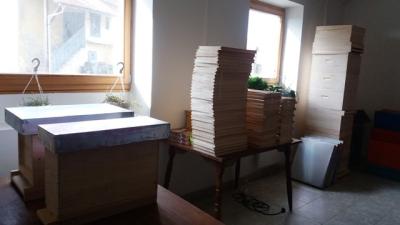
... link (0 Kommentare) ... comment
Consider bee propolis to be the “glue” that keeps everything together.
Initially, for propolis was thought to provide protection to the hive (e.g. rain, cold winds, snow). But protection is not only purpose of propolis, additionally it helps: reinforce hive structure and stability, minimize disruptive vibrations, prevent diseases and parasites from infecting the hives and mummify small intruders inside the hive.
Propolis is typically a mixture resin, composed of beeswax, saliva, sap and various botanical products in the surrounding area.
Propolis natural composition offers human an array of benefits when incorporated into a regular diet.
How did we collect propolis and make propolis tincture?
1. After we took honey out of hives, we laid propolis meshes in the hives. After one month we took them out of hives and put them into the freezer.
2. In January we decided to make propolis tincture.
3. We took propolis meshes from the freezer.
4. We scraped propolis out of the meshes with a knife.
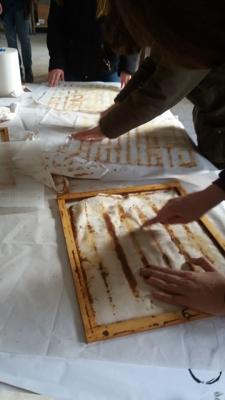
5. We placed propolis in the freezer and broke it in small pieces.
6. We ground propolis in a coffee grinder.

7. We put the propolis powder in a bottle and added alcohol. We added 300 ml of 98 % ethanol to 100 g of propolis. We shook it well.
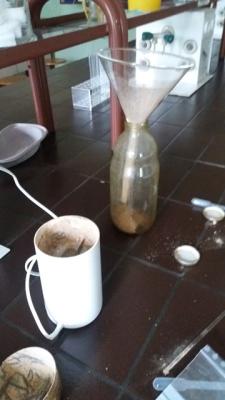
8. We stored the bottle in the darkness for about two weeks and shook it occasionally.
9. We filtered the tincture through a paper filter.


10. In a water bath we evaporated some ethanol.
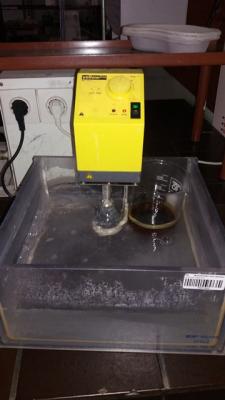
11. We stored the tincture closed in a clean dark bottle.
What are the effects of propolis on humans and in which diseases can it be used?
1. Propolis kills bacteria (Propolis has traditionally been used to kill colds and flu).
2. Propolis lowers blood pressure (If you suffer from hypertension, you may want to consider using raw honey, which contains propolis, as it has been proven to lower blood pressure.)
3. Propolis helps treat bone diseases (Another health benefit of propolis appears to be that it helps to build and maintain healthy bone tissue.)
4. Propolis helps treat allergies (An amazing health benefit of propolis is its ability to calm the symptoms of seasonal allergies.)
5. Propolis boosts prostate cancer cell death (Scientists examined the cancer killing effects of propolis tincture on two common types of prostate cancer. They concluded that propolis tincture markedly improved cell death in prostate cancer cells and suggested the significant role of propolis in chemoprevention of prostate cancer.)
6. Propolis kills colon cancer cells (Scientists found out that it caused the cancer cells to die by necrosis, which means that it interrupted the blood supply to the cell and caused just the local cancer cells to die and NOT healthy, living cells.)
7. Propolis may help treat food poisoning (Scientists found out that propolis inhibited the growth of C. jejuni, Enterobacter faecalis, and Staphylococcus aureus, the three bugs that are commonly found in food poisoning cases.)
8. Propolis protects injured teeth (It works against bacteria on teeth.)
9. Heat stress & athletic performance (An active ingredient in propolis known as caffeic acid phenethyl ester, or CAPE, triggers a broad spectrum of biological activities including antioxidant, anti-inflammatory and antiviral.)
10. Propolis is Effective Means Treatment for Warts (Propolis tincture killed a wart in less than two weeks.)
Propolis can affect very strong anti-inflammatory activity in many areas of the body. Inflammation is responsible for diseases such as arthritis, heart disease, Alzheimers, and many more. Much of the recent research indicates that one of the primary health benefits of propolis is its anti-inflammatory effects.
Chances are that people who consume propolis on a regular basis have less inflammation in their bodies and ultimately less disease, leading to healthier, longer lives.
... link (0 Kommentare) ... comment


In the cold winter days, students with their teachers cooked and distilled domestic spirit (Schnaps).
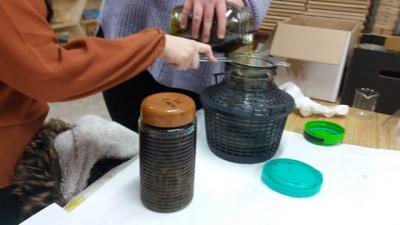
When everything was ready we decided to make herbal preparation against parasites.

Twelve herbs were used for the herbal preparation: peppermint (Mentha piperita), fennel (Foeniculum vulgare), thyme (Thymus vulgaris), goose grass (Galium aparine), chamomile (Chamomilla recutita), cayenne pepper (Capsicum frutescens), garlic (Allium sativum), wormwood (Artemisia absinthium), ginger (Zingiber officinale), cinnamon (Cinnamonum zeylanicum), fenugreek (Trigonella foenum-graecum) and liquorice (Glycyrrhiza glabra). The herbs were soaked in school brandy and filtered after one month. Some alcohol was later removed and honey with water (1:1) and propolis tincture was added to the preparation.
Animals can receive the herbal preparation orally at a dose of 0.1ml/kg of body weight for 5 days. The preparation eliminates internal parasites in animals, such as worms (helminths), tapeworms and protozoans.
The preparation is the result of the research work of our students. We also made a joint research of preparation with the Veterinary Faculty.
... link (0 Kommentare) ... comment
We all hope to visit Hamburg again.

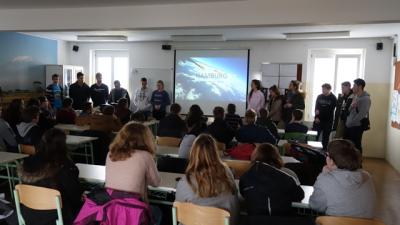
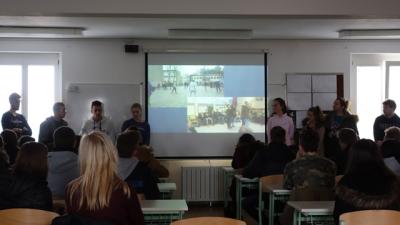


... link (0 Kommentare) ... comment